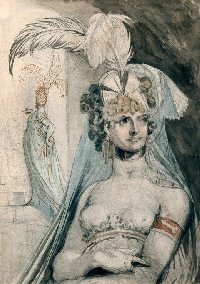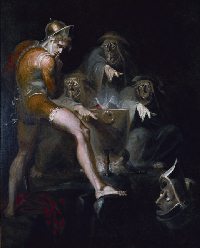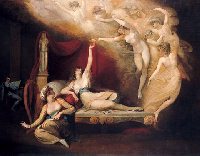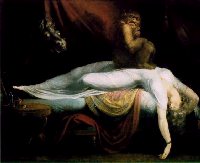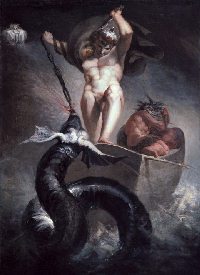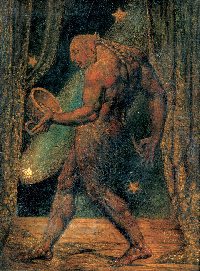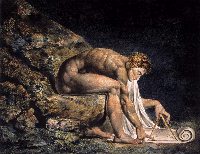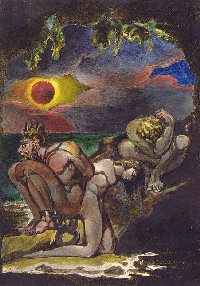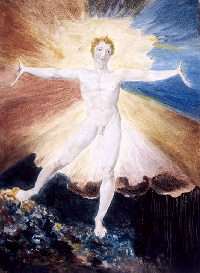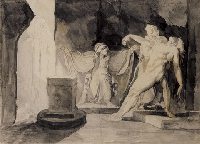| Henry Fuseli & William Blake
Masters of Gothic Romanticism
Henry Fuseli (1741-1825) Swiss painter, poet, critic, and teacher, a fervent admirer of Shakespeare, who spent most of his active career in England. Fuseli has often been regarded as a forerunner of the Romantic art movement and a precursor of Symbolism and Surrealism. His most famous painting is The Nightmare (1781), in which an ape-like goblin sits on a young woman, who is sleeping in a strained posture. The only man that ever I knew Henry Fuseli was born Johann Heinrich Füssli in Zürich into a family of artists and writers. His father was the portrait painter and art historian Johannes Kaspar Füssli. Although Fuseli's brothers and sisters became artists, his father directed him towards priesthood. He studied theology at Caroline College in Zurich, where he was taught by Professor J.J. Bodmer, an early promoter of the Sturm und Drang movement in Switzerland. Later Fuseli portrayed him an a work entitled The Painter in Conversation with Johann Jakob Bodmer (1778-81). Fuseli was ordained a Zwinglian clergyman in 1761. Next year, in consequence of a pamphlet, in which he attacked Felix Grebel, the corrupted administration of a magistrate, he had to leave Zurich. Fuseli's fellow-polemicist, the theologian Johann Casper Lavater, later descibed his energetic friend: "His spirits are hurricane, his servants flames of fire. He goes on the wings of the wind. His laugh is the mockery of Hell, and his love a murderous lightning flash." Fuseli traveled through Germany, and spent then much time in Berlin. There worked on a German translation of Lady Mary Wortley Montagu's Letters, which was published in 1763. Lavater and Fuseli remained friends. Fuseli's translation of Lavater's Aphorisms on Man appeared in 1788. He also illustrated the original German and French editions of Lavater's Physiognomical Fragments. In 1764, Fuseli went to London to work as a translator of French, German, and Italian books. At the age of twenty-four, he translated into English Reflections on the Painting and Sculpture of the Greeks by the German Neo-Classical theorist J.J. Winkelmann. However, Fuseli did not become Winkelmann's follower. He also admired another great intellectual figure of the time, Jean-Jacques Rousseau, whom he met, but eventually broke with his ideas. Fuseli's book on the French philosopher, Remarks on the Writing and Conduct of J. J. Rousseau, was published anonymously in 1767. Fuseli was an active writer until 1768 without much success. Because he could not support himself by his pen, he served as a traveling tutor to the young Lord Chewton, a work which he did not like and which was much against his temperement. Fuseli had "the wildness of the warrior", as Lavater said, and a punch-up ended eventually his appointment. On the advice of the famous portrait painter Joshua Reynolds (1723-92), who encouraged Fuseli to devote himself to painting, he went in 1770 to Rome for eight years. There he abandoned Winkelmann's refined aestheticism-"noble simplicity and quiet grandeur" just was not his program. Fuseli taught himself, mainly by copying Michelangelo's frescoes in the Sistine Chapel and drawing from antique sculptures. Among Fuseli's most haunting works dealing with antique is The Artist in Despair over the Magnitude of Antique Fragments (1778-80), in which only a hand, pointing upwards, and a foot, have remained from a colossal statue (of Constantine the Great). Although Fuseli's technique was highly personal and experimental, his choice of themes influenced so much the other foreign artists in Rome, that he became virtually the leader of a school of painting. His circle included Alexander and John Runciman, the Swedish sculptor Johan Tobias Sergel, the English artist Thomas Banks, and the Danish painter Nicolas Abildgaard. "There is living in Rome a noble German from Zurich, Henry Fuseli," wrote Johann Herder in 1774 in a letter to Johann Hamann, "a genius like a mountain torrent, a worshipper of Shakespeare, and now, Shakespeare's painter." On his return to Zurich Fuseli painted The Oath of the Ruttli (1779-81), which was destined for the Town Hall. After his romance with Lavater's niece Anna Landolt failed, he left in 1779 for London. It is though that his best-known scene, The Nightmare, refers to this affair. A young woman is mounted by a demonic looking incubus; the monster literally is a burden on her heart. She lies in a sprawl, with her arm hanging down. A horse, the "night mare" gazes through the curtains with phosphorescent eyes, observing or leering. It has remained a puzzle, whose nightmare Fuseli portrays-it cannot be the woman's because she is part of the scene herself. It has been said, that the picture is an revenge for an unfulfilled desire, ultimately perhaps a manifestation of a jealous passion, in which the strange lover of the woman is reduced into a monster. The work became so popular that Fuseli painted several other versions on request. One version of The Nightmare was published in Erasmus Darwin's poem The Botanic Garden (1789-91). In France, The Nightmare inspired Charles Nodier's fantasy story Smarra, ou Les Démons de la nuit (1821). Fuseli himself was careful not to be tempted by "fancy" and the unknown, but believed in the possible, the probable, and the known-"our ideas are the offspring of our senses," he once said. A Sleeping Woman and the Furies (1821) took the sexual undertones even further. Now the woman is half-naked and her figure suggest that she has been violated. Another cruel fantasy was Wolfram Looking at his Wife, whom he has Imprisoned with the Corpse of her Lover (1812-20). From these and other works it has been concluded, that Fuseli was a misogynist and he feared and loathed dominant women. In 1788 Fuseli married Sophia Rawlins, whom he used as a model in a number of erotic and macabre paintings. In Mrs. Fuseli Seated by a Fireplace (1799) she was also referred in the figure of the feared Medusa; the sight of her head turned all living things into stone. The early feminist Mary Godwin (Wollstonecraft), whose portrait Fuseli painted, planned a trip with him to Paris, but after Sophia's intervention the Fuselis door was closed to her forever. "I hate clever women," Fuseli once said, "they are only troublesome." Fuseli's 'Milton Gallery', which was exhibited in 1799, was a financial failure. Fuseli also illustrated Dante, Spenser's Faerie Queen, Nordic myths and legends, the Niebelungenlied, medieval poems, and fairy tales. However, at the beginning of his career, he was most attracted to the plays of William Shakespeare. For him Shakespeare was "the supreme master of passions and the ruler of our hearts". As a teenager he had translated Macbeth into German. In the 1760s Fuseli had seen the famous actor David Garrick in the role of Macbeth and produced a watercolor portraying Macbeth and Lady Macbeth after the murder of Duncan. Later he returned to this play in several paintings in which the figures are surrounded by mysterious darkness, among them Macbeth conculting the vision of the Armed Head, painted for the Shakespeare Gallery in Dublin. The faces of the three sisters in the work were modelled on the face of his old mentor, Johann Jakob Bodmer. His other favorite works included Hamlet and A Midsummer Night's Dream, for which he produced numerous sequences. From 1786, Fuseli contributed actively to Boydell's 'Shakespeare Gallery'. Fuseli had read Shakespeare's plays so thoroughly that he supposedly was able to recollect any passage that was quoted. For the Analytical Review Fuseli started to write in 1788 essays and reviews. With Thomas Paine, William Godwin, Joseph Priestley, Erasmus Darwin, Mary Wollstonecraft, and other men and women interested in art, literature and politics, Fuseli frequented the home of Joseph Johnson, a publisher and prominent figure in radical British political and intellectual life. When Louis XVI was executed in France in 1793, he condemned the revolution as despotic and anarchic, although he had first welcomed it as a sign of "an age pregnant with the most gigantic efforts of character." In 1799 he was appointed professor of painting at the Royal Academy, and keeper of the Academy in 1804. Among his pupils were John Constable (1776-1837), the major English landscape painter of his time, Benjamin Robert Haydon (1786-1846), William Etty (1787-1849), and Edwin Landseer (1802-73), who first exhibited at the age of twelve. William Blake, who was sixteen years his junior, recognized a debt to him, and for a time many English artist copied his mannerisms. Fuseli died on April 16, 1825, at the Countess of Guilford's country residence at Putney Hill. He was buried at St Paul's Cathedral, near to Sir Joshua Reynolds. After Fuseli's death, Sophia burned many of the erotic drawings, which were not meant for the art audience. Fuseli's work fell mostly into neglect. His reveries inspired Edgar Allan Poe's short story 'The Fall of the House of Usher', but it was not until the 20th century when his surrealistic works were rediscovered. Among his admirers was H.P. Lovecraft, who confessed that "Fuseli really brings a shiver while a cheap ghost-story frontispiece merely makes us laugh." The Nightmare probably inspired also Salvador Dali's painting Invisible Sleeping Woman, Horse, Lion (1930). Fuseli's works drew from Neoclassic harmony and narrative clarity, Romantic eroticism, and Mannerist distortions. The gestures and movement of his figures were exaggerated, as if they were actors on a stage. Male bodies have oversteressed muscles; they are men of action, not thinkers. Fuseli himself was an avid theatergoer, which perhaps explains also some of his most dramatic light effects. There is a peculiar disparity between what Fuseli painted and what he wrote about his art. The great name of German Romanticism, Casper David Friedrich (1774-1840) fully accepted the split between the inner and outer vision. "Follow unconditionally the voice of your inner self," was his doctrine, "because this is the divine in us, and it does not lead us astray." Fuseli's Lectures on Painting (1801-30), originally given at the Royal Academy in London, followed the traditional juxtaposition between the history of ancient and "modern" art, without giving a view into his inner thoughts. However, Fuseli's studio was furnished in the style of his paintings. When his pupil Benjamin Robert Haydon visited it, he was amazed by its "Galvanized devils-malicious witches brewing their incantations-Satan bringing Chaos, and springing upward like a pyramid of fire-Lady Macbeth-Paolo and Francesca-Falstraff and Mrs Quickly-humour, pathos, terror, blood and murder met one at every look! I expected the floor to give way-I fancied Fuseli himself to be a giant." Fuseli's ghostly and frightening subject-matter was a visual continuum of the Gothic novel, which developed an aesthetics of terror and horror, was occupied with dreams and the unconscious, and often looked back to the feudal world. Fuseli once said, that "one of the most unexplored regions of art are dreams and what may be called the personification of sentiments." However, Fuseli himself showed little interest in dreams and inner workings of the psyche, with one exception-like the Romantic writers of the younger generation, Thomas De Quincey and Samuel Taylor Coleridge, Fuseli used opium. For further reading: Fuseli, Dichter und Maler by Arnold Federmann (1927); Fuseli by Rudolf Beutler (1939); The Drawings of Henry Fuseli by Paul Ganz (1949); The Mind of Henry Fuseli, ed. by Eudo Mason (1951); The Drawings of Henry Fuseli, edited by C.N.P. Powell (1951); Fuseli Studies by Frederick Antal (1956); J.H. Fuseli by Gert Schiff (1968); The Life and Art of Henry Fuseli by Peter Tomory (1972); Fuseli: The Nightmare by Nicholas Powell (1973); The Fuseli Circle in Rome: Early Romantic Art of the 1770s by Nancy L. Pressly (1979); Phantoms of the Imagination by A.M. Hammacher (1981); Blake and Fuseli: A Study in the Transmission of Ideas by Carol Louise (1985); Prints and Engraved Illustrations by and After Henry Fuseli: A Catalogue Raisonné by D. H. Weinglass (1994); Fuseli to Menzel: Drawings and Watercolors in the Age of Goethe from a German Private Collection by Hinrich Sieveking (1998); Fuseli by Federico Zeri (2001); Henry Fuseli by Martin Myrone (2001) Selected works:
|
|
|
William Blake (1757-1827)
British poet, painter, visionary mystic, and engraver, who illustrated and printed his own books. Blake proclaimed the supremacy of the imagination over the rationalism and materialism of the 18th-century. He joined for a time the Swedenborgian Church of the New Jerusalem in London and considered Newtonian science to be superstitious nonsense. Misunderstanding shadowed his career as a writer and artist and it was left to later generations to recognize his importance. To see a world in a grain of sand William Blake was born in London, where he spent most of his life. His father was a successful London hosier and attracted by the doctrines of Emmanuel Swedenborg. Blake was first educated at home, chiefly by his mother. His parents encouraged him to collect prints of the Italian masters, and in 1767 sent him to Henry Pars' drawing school. From his early years, he experienced visions of angels and ghostly monks, he saw and conversed with the angel Gabriel, the Virgin Mary, and various historical figures. At the age of 14 Blake was apprenticed for seven years to the engraver James Basire. Gothic art and architecture influenced him deeply. After studies at the Royal Academy School, Blake started to produce watercolors and engrave illustrations for magazines. In 1783 he married Catherine Boucher, the daughter of a market gardener. Blake taught her to draw and paint and she assisted him devoutly. In 1774 Blake opened with his wife and younger brother Robert a print shop at 27 Broad Street, but the venture failed after the death of Robert in 1787. Blake's important cultural and social contacts included Henry Fuseli, Reverend A.S. Mathew and his wife, John Flaxman (1755-1826), a sculptor and draftsman, Tom Paine, William Godwin, and Mrs Elizabeth Montagu (1720-1800), married to the wealthy grandson of the earl of Sandwich. His early poems Blake wrote at the age of 12. However, being early apprenticed to a manual occupation, journalistic-social career was not open to him. His first book of poems, POETICAL SKETCHES, appeared in 1783 and was followed by SONGS OF INNOCENCE (1789), and SONGS OF EXPERIENCE (1794). His most famous poem, 'The Tyger', was part of his Songs of Experience. Typical for Blake's poems were long, flowing lines and violent energy, combined with aphoristic clarity and moments of lyric tenderness. Blake was not blinded by conventions, but approached his subjects sincerely with a mind unclouded by current opinions. On the other hand this made him also an outsider. He approved of free love, and sympathized with the actions of the French revolutionaries but the Reign of Terror sickened him. In 1790 Blake engraved THE MARRIAGE OF HEAVEN AND HELL, a book of paradoxical aphorisms and his principal prose work. "If the doors of perception were cleansed everything would appear to man as it is, infinite." (from The Marriage of Heaven and Hell) The work expressed Blake's revolt against the established values of his time: "Prisons are built with stones of Law, brothels with bricks of Religion." Radically he sided with the Satan in Milton's Paradise Lost and attacked the conventional religious views in a series of aphorisms. But the poet's life in the realms of images did not please his wife who once remarked: "I have very little of Mr. Blake's company. He is always in Paradise." Some of Blake's contemporaries called him a harmless lunatic. The Blakes moved south of the Thames to Lambeth in 1790. During this time Blake began to work on his 'prophetic books', where he expressed his lifelong concern with the struggle of the soul to free its natural energies from reason and organized religion. Although Blake first accepted Swedenborg's ideas, he eventually rejected him. He wrote THE VISIONS OF THE DAUGHTERS OF ALBION (1793), AMERICA: A PROPHESY (1793), THE BOOK OF URIZEN (1794), and THE SONG OF LOS (1795). Blake hated the effects of the Industrial Revolution in England and looked forward to the establishment of a New Jerusalem "in England's green and pleasant land." Between 1804 and 1818 he produced an edition of his own poem JERUSALEM with 100 engravings. "Bring me my Bow of burning gold: In 1800 Blake was taken up by the wealthy William Hayley, poet and patron of poets. The Blakes lived in Hayley's house at Felpham in Sussex, staying there for three years. At Felpham Blake worked on MILTON: A POEM IN TWO BOOKS, TO JUSTIFY THE WAYS OF GOD TO MEN. It was finished and engraved between 1803 and 1808. In 1803 Blake was charged at Chichester with high treason for having 'uttered seditious and treasonable expressions, such as "D-n the King, d-n all his sibjects..."' but was acquitted. In 1809 Blake had a commercially unsuccessful exhibition at the shop once owned by his brother. However, economic problems did not depress him, but he continued to produce energetically poems, aphorisms, and engravings. "The tigers of wrath are wiser than the horses of instruction," he wrote. From 1818 Blake started to enjoy the admiration of a group of young disciples. Blake's last years were passed in obscurity, quarreling even with some of the circle of friends who supported him. Among Blake's later artistic works are drawings and engravings for Dante's Divine Comedy and the 21 illustrations to the book of Job, which was completed when he was almost 70 years old. Blake never shook off the poverty, in large part due to his inability to compete in the highly competitive field of engraving and his expensive invention that enabled him to design illustrations and print words at the same time. Independent through his life, Blake left no debts at his death on August 12, 1827. He was buried in an unmarked grave at the public cemetery of Bunhill Fields. Wordsworth's verdict after Blake's death reflected many opinions of the time: "There was no doubt that this poor man was mad, but there is something in the madness of this man which interests me more than the sanity of Lord Byron and Walter Scott." Blake's influence grew through Pre-Raphealites and W.B. Yeats. especially in Britain. His interest in legend was revived with the Romantics' rediscovery of the past, especially the Gothic and medieval. In the 1960s Blake's work was acclaimed by the Underground movement. T.S. Eliot wrote in his essay on Blake that "the concentration resulting from a framework of mythology and theology and philosophy is one of the reasons why Dante is a classic and Blake only a poet of genius." (from Selected Essays, 1960) For further information: Blake in the Nineties, ed. by Steve Clark, David Worrall (1999); The Chained Bo: Orc and Blake's Idea of Revolution by Christopher Z. Hobson (1999); Blake, Politics, and History, ed. by Jackie Disalvo et al (1998); The Dialectic of Vision: A Contrary Reading of William Blake's Jerusalem by Fred Dortort, Donald Ault (1998); Blake, Ethics, and Forgiveness by Jeanne Moskal (1994); Encounter With the Self: A Jungian Commentary on William Blake's Illustrations of the Book of Job by Edward F. Edinger (1986); Blake and Swedenborg, ed. by Rahl Bellin, Harvey Bellin (1985); A Blake Bibliography by G.E. Bentley Jr. and M.K. Nurmi (1977); Blake Books by G.E. Bentley Jnr (1977); A Blake Dictionary: The Ideas and Symbols of William Blake by S. Foster Damon (1979) William Blake and the Age of Revolution by J. Bronowski (1965); William Blake: A New Kind of Man by M. Davis (1977); Blake's Apocalypse by M.D. Paley (1970); The Complete Writings of William Blake by G. Keynes (1966); Fearful Symmetry: A Study of William Blake by Northrop Frye (1947); The Life of William Blake by Mona Wilson (1927, ed. G. Keynes, 1971); The Life of William Blake by Alexander Gilchrist (1863). - See also: Jim Morrison, Kenzaburo Oe, Emanuel Swedenborg
Selected works:
| |
